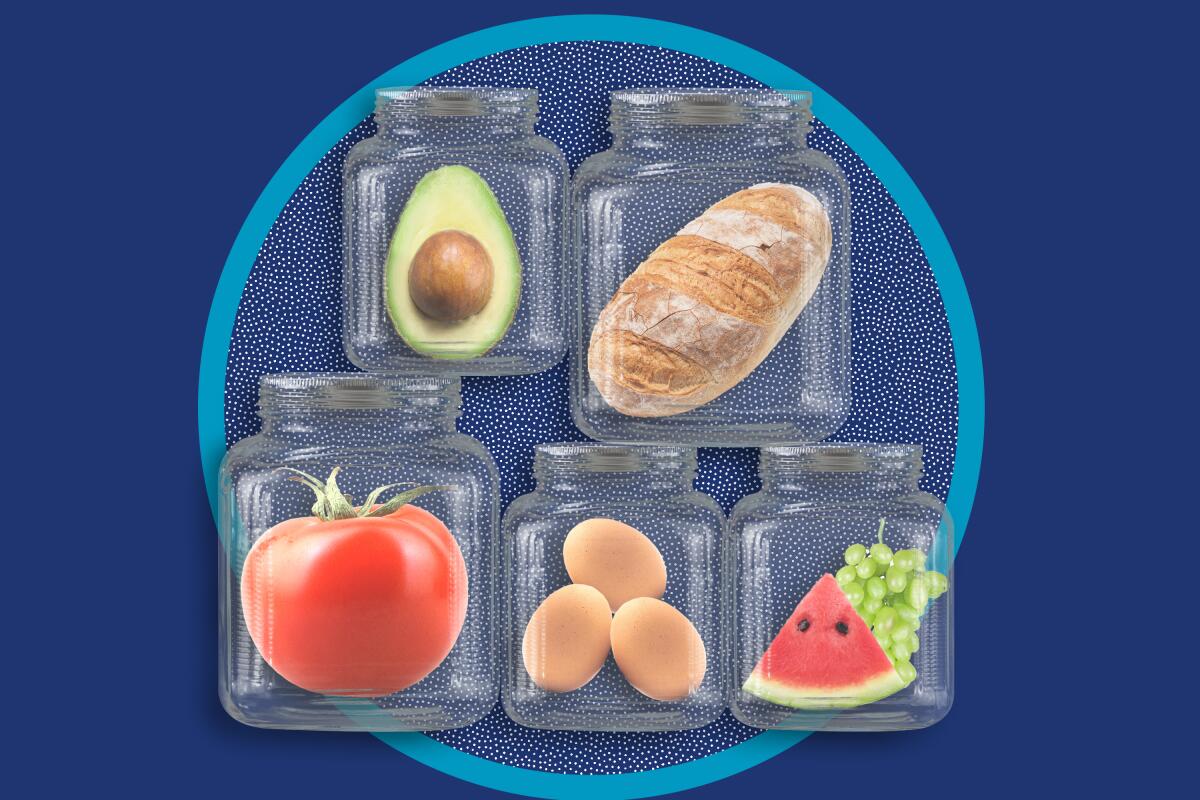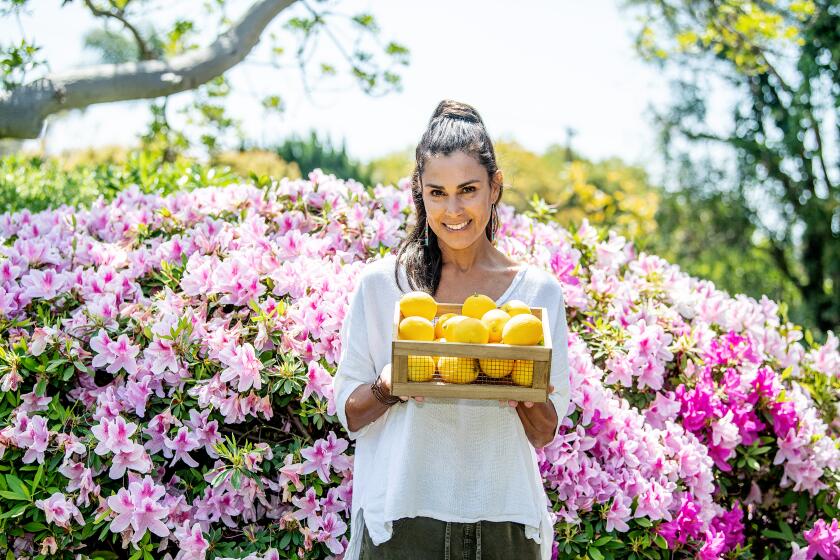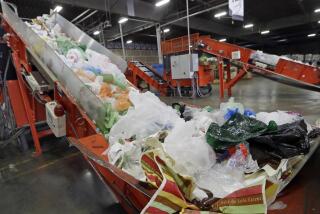Most food waste in the U.S. occurs at the consumer level. You can do something about it

- Share via
Anne-Marie Bonneau, who writes the food blog “Zero-Waste Chef,” has lived plastic-free since 2011. The tips below on freezing, storing and shopping come from her new cookbook, “The Zero-Waste Chef: Plant-Forward Recipes and Tips for a Sustainable Kitchen and Planet,” published by Avery.
PRESERVING FOOD IN THE FREEZER
Cook and freeze large amounts of food to enjoy later, preserve seasonal foods like summer berries, and prevent food waste by squirreling away food that you won’t eat immediately.
Freezing without plastic
When I post pictures of my jar-filled freezer on social media, I get lots of questions about it, usually along the following lines: Is it safe to freeze food in glass? (Yes.) Do you use special glass for the freezer? (No, I use a variety of everyday jars — recycled jars, Mason jars, big jars, small jars.) Don’t your glass containers break? (Only that one time.) I have had little trouble freezing food in glass. I do, however, take precautions:
• Always leave headspace in jars. When liquid freezes, it expands. If you don’t leave space for this expansion, your glass jar can break.
• Choose wide-mouth jars without necks or shoulders. Straight, flush sides work best for freezing.
• Don’t put jars full of hot food into the freezer. I have noticed that when I allow the food to cool at room temperature and then chill it overnight in the refrigerator before freezing it, very few ice crystals form on top of the food.
• Thaw in the refrigerator. The night before you need it, transfer your jar of frozen food to the refrigerator to thaw or at least thaw enough so you can remove the food from the jar to heat it or cook with it.
Some of what I freeze:
• Beans. I cook beans in my pressure cooker and freeze extra beans in jars. I usually freeze them in their broth. I also freeze broth from cooked beans to use later in various dishes calling for vegetable broth.
• Bread. When I bake sourdough bread, I usually freeze a whole loaf in a homemade cloth produce bag. I find that slices get freezer burn quickly. I don’t freeze bread for very long — a couple of weeks maximum.
• Eggs. Crack them into a jar, whisk them and freeze them. Egg whites also freeze well.
• Fruit. I don’t buy frozen fruit because it’s packaged in plastic bags. Instead, I freeze fruit near the end of the season. I wash the pieces, slice them or pit them, spread them out on a cookie sheet in a single layer and put that in the freezer. Once the fruit has frozen, I transfer it to glass jars.
• Roasted tomatoes. In the summer, I roast and freeze at least a couple of crates of Early Girl tomatoes and use these in place of canned tomatoes.
WHERE TO STORE PRODUCE FOR OPTIMAL FRESHNESS
If you will eat what you buy within one to three days, most of your produce will keep well on the kitchen counter, away from direct sunlight. But the truth is most of us can’t shop every couple of days.
Store it outside the refrigerator.
Refrigerator temperatures — generally around the mid-30s — damage the flavor and texture of many types of produce. Never store tomatoes in the refrigerator unless you enjoy a mealy texture bereft of flavor. Keep them at room temperature (ideally, not too warm a room), along with avocados, bananas, melons, pumpkins, potatoes (including sweet potatoes) and winter squash. Onions and shallots also keep better without refrigeration but away from potatoes, as the two react and can speed up each other’s demise.
Store it inside the refrigerator.
After harvest, vegetables continue to breathe, consuming oxygen and emitting carbon dioxide and water. Vegetables that respire at a higher rate keep better in the refrigerator crisper, where food retains more moisture than in the open space of the main refrigerator compartment, which can draw moisture out of produce. Vegetables with higher respiration rates include artichokes, asparagus, broccoli, Brussels sprouts, scallions, mushrooms and sweet corn.
Store your breathing vegetables in cloth produce bags so they can continue to breathe. Larger vegetables like cabbage and cauliflower don’t require a produce bag to transport home and can go naked into the crisper.
Store it in a jar of water.
Some vegetables keep for a long time stored in a jar of water at room temperature. These include asparagus, basil, and celery.
Food insecurity continues to dominate the lives of millions of Americans, and hyperlocal apps and online groups are popping up to help fill some of the gaps.
GOOD, BETTER, BEST ZERO-WASTE SHOPPING
GOOD
Produce
If you don’t have access to farmers markets, try these strategies:
• Shop with reusable produce bags. Take reusable cloth produce bags to the grocery store for buying produce. Fill your bags with loose apples, carrots, potatoes and so on. Buy greens such as bunches of spinach and romaine lettuce rather than those prepped in plastic bags. Save all the stems for vegetable broth.
• Some items don’t need a produce bag. A bunch of bananas, a couple of onions or a squash can go directly into your shopping cart and then into your shopping bag.
• Join a CSA (community supported agriculture) and request no plastic.
Pantry staples
If you don’t have a good bulk store near you, here’s what you can do to reduce your product-to-packaging ratio:
• Buy giant packages of food. If you and your family will eat 25 pounds of rice, then buy the 25-pound bag of rice.
• Split giant packages of food with friends and neighbors.
BETTER
Produce
If your city has one, shop at the farmers market. Produce at my farmers market has very little packaging, it tastes better than anything I can buy in a store, and I enjoy varieties of fruit and vegetables I won’t find in a grocery store. I can also buy “ugly” fruits and vegetables that most supermarkets refuse to carry, which helps reduce food waste. More of my money goes directly to the farmers, which helps them stay in business.
Pantry staples
If you do have access to bulk bins but the store won’t allow you to use your own containers and produce bags:
• Reuse the store’s plastic bags. If the store insists you must use its plastic bags for bulk shopping, and you reuse those bags, how will anyone ever know if you don’t use a new bag every time? I’m just asking.
• Complain. Explain to store management that they will buy fewer plastic bags and save money if they allow people to bring their own bags.
BEST
Produce
Extend the season. For example, near the end of summer, when you can buy piles of tomatoes cheaply, you can preserve them in a number of ways.
• Roast and freeze tomatoes. Every summer, I buy two to four 20-pound cases of tomatoes. I roast the tomatoes and freeze them to cook with throughout the winter.
• Dehydrate tomatoes. I’ve dehydrated tomatoes in a solar food dryer, and they taste like candy. I would keep them through the winter but we eat them all because they taste so good. You can dehydrate these in the oven on a very low temperature.
• Can tomatoes. Put up several Mason jars’ worth and enjoy tomatoes all winter long.
Pantry staples
If you have access to bulk bins in a store that allows you to bring your own reusable containers and bags, you can:
• Fill your jars with zero-waste abandon. Have your jars or other containers weighed before you fill them with food.
I’m lucky enough to live close to bulk stores with very good selections. Every few months, I buy a large haul. I’ll take 20 to 25 reusables to fill — both jars and my produce/bulk-bin bags. Think of all the trash you’ll divert from a landfill.
Vegetable Scraps Broth
More to Read
Eat your way across L.A.
Get our weekly Tasting Notes newsletter for reviews, news and more.
You may occasionally receive promotional content from the Los Angeles Times.












